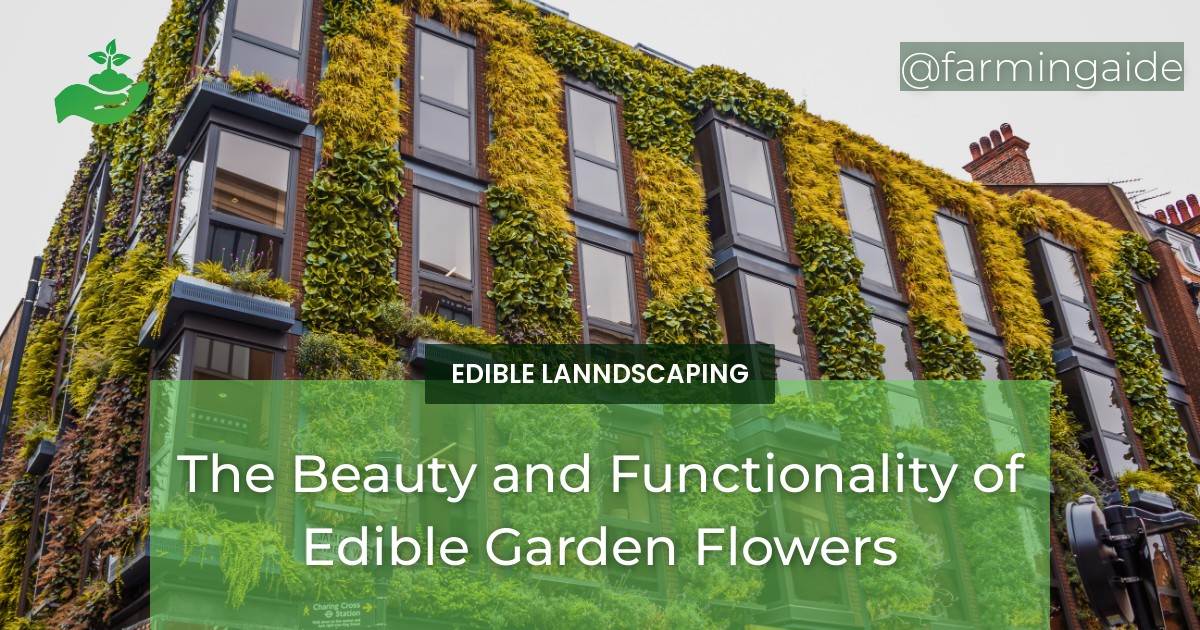Welcome to the world of edible garden flowers! These beautiful and functional plants are a must-have for any garden, providing both visual appeal and practical benefits. From adding color and texture to your garden design to providing a source of food and medicine, edible garden flowers are a versatile and valuable addition to any outdoor space. In this article, we will explore the beauty and functionality of edible garden flowers, from plant selection to sustainable gardening practices. Whether you are a seasoned gardener or just starting out, this comprehensive guide will provide you with all the information you need to create a stunning and productive edible garden. So let’s dive in and discover the wonders of edible garden flowers!
The Benefits of Edible Garden Flowers
Edible garden flowers offer a wide range of benefits, making them a popular choice among gardeners. Here are some of the top reasons to include them in your garden design:
- Visual appeal: Edible garden flowers come in a variety of colors, shapes, and sizes, making them a beautiful addition to any garden. They can add a pop of color, texture, and interest to your outdoor space.
- Source of food: Many edible garden flowers are not only visually appealing but also delicious and nutritious. They can be used in salads, teas, and other dishes, providing a fresh and unique flavor to your meals.
- Medicinal properties: Some edible garden flowers have medicinal properties and have been used for centuries to treat various ailments. For example, calendula flowers have anti-inflammatory and antiseptic properties, while chamomile flowers can help with relaxation and sleep.
- Attract pollinators: Edible garden flowers are a great way to attract pollinators such as bees, butterflies, and birds to your garden. This can help with the pollination of other plants in your garden, leading to a more abundant harvest.
- Sustainable gardening: By growing your own edible garden flowers, you can reduce your carbon footprint and promote sustainable gardening practices. This can include using organic methods, composting, and practicing crop rotation.
Plant Selection for Edible Garden Flowers
When it comes to selecting edible garden flowers, there are a few things to keep in mind. First, make sure to choose flowers that are safe to eat and have not been treated with any chemicals. You can either purchase seeds or plants from a reputable source or grow them from seeds yourself. Some popular edible garden flowers include:
- Nasturtiums: These vibrant flowers have a peppery flavor and can be used in salads, sandwiches, and as a garnish.
- Roses: Rose petals are not only beautiful but also have a delicate flavor that can be used in desserts, teas, and syrups.
- Lavender: This fragrant flower can be used in cooking, baking, and as a calming tea.
- Pansies: These colorful flowers have a mild flavor and can be used in salads, desserts, and as a garnish.
- Marigolds: These bright flowers have a citrusy flavor and can be used in salads, soups, and as a natural food coloring.
It’s important to note that not all parts of the flower are edible, so make sure to do your research before consuming any part of the plant. Also, be sure to only harvest flowers from plants that have not been treated with pesticides or other chemicals.
Designing Your Edible Garden
When incorporating edible garden flowers into your garden design, there are a few things to consider. First, make sure to choose a sunny spot for your flowers to thrive. Most edible garden flowers prefer full sun, although some can tolerate partial shade. Next, consider the size and shape of your garden. You can plant edible garden flowers in containers, raised beds, or directly in the ground. Make sure to leave enough space between plants for proper air circulation and growth.
Another important aspect of garden design is companion planting. This is the practice of planting certain plants together to benefit each other. For example, planting marigolds near tomatoes can help repel pests, while planting lavender near carrots can improve their flavor. Do some research on companion planting to find the best combinations for your edible garden.
Sustainable Gardening Practices for Edible Garden Flowers
To ensure the health and productivity of your edible garden flowers, it’s important to practice sustainable gardening methods. This includes using organic fertilizers and pesticides, composting, and practicing crop rotation. Organic fertilizers, such as compost or manure, provide essential nutrients to the soil without harmful chemicals. Composting is a great way to recycle kitchen and garden waste and create nutrient-rich soil for your plants. Crop rotation involves planting different crops in different areas each season to prevent soil depletion and reduce the risk of pests and diseases.
How Can Edible Garden Flowers Be Incorporated into Hydroponic Vertical Gardening?
Edible garden flowers can easily be incorporated into vertical gardening with water by using hydroponic systems. With the right setup, flowers like nasturtiums and lavender can thrive without soil, making them perfect for vertical gardens. This method allows for a beautiful and space-saving way to grow a variety of edible blooms.
Conclusion
In conclusion, edible garden flowers are not only beautiful but also offer a wide range of benefits. From adding color and flavor to your meals to promoting sustainable gardening practices, these versatile plants are a must-have for any garden. By carefully selecting and designing your edible garden, and practicing sustainable gardening methods, you can enjoy a bountiful harvest of delicious and nutritious flowers. So why not add some edible garden flowers to your garden design and reap the rewards of their beauty and functionality?
RELATED ARTICLES:


